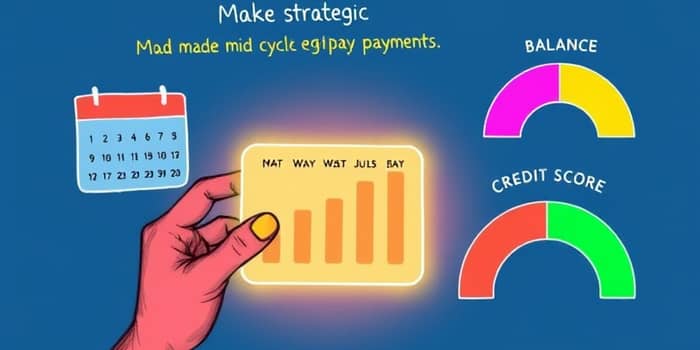Unlocking the secrets of credit scoring can transform your financial life. One popular tactic, often called the “15/3 hack,” promises rapid improvements by splitting payments across the cycle. But does it really work? In this article, we’ll explore the mechanics, debunk myths, and guide you through actionable strategies to harness mid-cycle payments for your benefit.
Understanding Credit Utilization
Your credit utilization ratio—calculated as total balances divided by total limits—accounts for roughly 30% of your FICO score. Keeping this ratio low is one of the simplest ways to improve your standing. Experts recommend maintaining a utilization rate under 30%, and ideally under 10%, to maximize your score potential.
When issuers report to credit bureaus, they typically send a snapshot of your balance on the statement closing date. If you carry a high balance at that moment, it can drag down your score, even if you pay in full by the due date. By paying before the statement closes, you can reduce your balance before close and influence the figure that gets reported.
Debunking the 15/3 Myth
The so-called 15/3 hack suggests making two payments each cycle—one 15 days before due date, another three days before—to register two on-time payments. This claim is misleading. Credit bureaus only record a single on-time payment flag per billing cycle, regardless of how many payments you make.
True benefits stem solely from lowering your reported balance at statement close, not from increasing your on-time payment count. Payments after the closing date have no impact on that month’s reported utilization, and issuers do not report multiple payments per cycle.
How Mid-Cycle Payments Work
Imagine you carry a $2,000 balance on a card with a $4,000 limit. On the statement closing date, your utilization would stand at 50%. If you pay $1,000 seven days prior, your utilization drops to 25% at reporting time. By scheduling another mid-cycle payment, you ensure your balance remains low. This strategy can yield a noticeable bump when bureaus update your file.
In practical terms, you can make as many payments as your cash flow allows. The timing relative to your statement closing date is what matters most. A single well-timed payment can be more effective than multiple less-strategic ones.
Remember that small changes can be impactful within the next reporting cycle. Even a 5% drop in utilization can yield a measurable score increase, especially if your prior ratio hovered above 30%.
Who Benefits Most
- Those with low credit limits relative to spending—mid-cycle payments help avoid high utilization snapshots.
- Consumers who carry balances month to month—more frequent payments also reduce average daily balance and interest charges.
- Applicants for large loans—mortgage or auto lenders often pull scores near closing; a quick utilization drop can mean thousands in savings.
Potential Pitfalls and Limitations
If you already pay in full and maintain low utilization, additional payments offer minimal benefit. Avoid overcomplicating your routine unless you face persistent high balances. Excessive vigilance can lead to stress and unnecessary accounting.
Furthermore, the exact 15/3 schedule is arbitrary. The crucial factor is ensuring your balance is low on your statement closing date. Payments before that snapshot will register; after, they won’t impact utilization until next cycle.
Actionable Strategies for Quick Score Improvement
- Identify your statement closing date—consult your issuer or review billing statements.
- Schedule a payment a few days before that date to lower your utilization rate dramatically.
- Set up automated mid-cycle transfers or reminders to avoid missed timing.
- Consider multiple small payments if a lump sum isn’t feasible; consistency is key.
- Monitor your credit score weekly to observe changes after reporting updates.
Summary of Mid-Cycle Payment Impact
Building Long-Term Credit Strength
While mid-cycle payments offer a fast boost, sustainable credit health relies on consistent habits. Maintain an ideal utilization rate by keeping balances low, and pay at least the minimum due on time every month. Over time, your payment history—which comprises 35% of your FICO score—will reflect reliability.
Other long-term strategies include requesting credit limit increases, keeping older accounts open to lengthen your history, and diversifying your credit mix. By combining these with strategic timing, you set yourself up for both immediate gains and lasting progress.
Conclusion
Mid-cycle payments can be an empowering tool when wielded correctly. By planning ahead, you can empower your financial future today through smarter utilization management. Whether you’re prepping for a major loan or simply aiming for a healthier score, understanding the nuances of reporting dates and balances will put you a step ahead.
Implement these tactics consistently, track your progress, and celebrate each milestone. Your credit score is more than a number—it’s a reflection of your financial discipline and potential. Use these insights to build confidence, reduce costs, and pursue your goals with greater ambition.
References
- https://www.experian.com/blogs/ask-experian/15-3-credit-card-hack/
- https://www.nerdwallet.com/article/credit-cards/15-3-credit-card-hack-is-not-true
- https://www.nasdaq.com/articles/the-15-3-credit-card-hack-is-nonsense-heres-what-to-do-instead
- https://www.sofi.com/learn/content/15-3-credit-card-payment/
- https://www.self.inc/blog/15-3-credit-hack
- https://www.bankrate.com/credit-cards/advice/credit-utilization-ratio/
- https://www.nerdwallet.com/article/finance/credit-score-ranges-and-how-to-improve
- https://use.expensify.com/blog/credit-card-hacks










